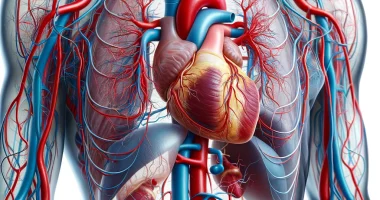Carotid artery disease
Definition
Carotid artery disease is a chronic systemic disease characterized by the deposition of lipid plaques in the carotid vessels. Pathology occurs when lipid metabolism disorders are combined with inflammatory changes in the intima of the arteries and an increased propensity to thrombosis. Carotid atherosclerosis is characterized by an asymptomatic course. Clinical manifestations occur only when complications develop. For diagnosis, duplex ultrasound of vessels, angiography, CT, or brain MRI are used. Treatment involves hypolipidemic therapy, lifestyle correction, and removal of large plaques by minimally invasive or surgical means.
General information
Carotid atherosclerosis has an important clinical significance. The disease is called one of the main predictors of vascular complications, including strokes and transient ischemic attacks. Screening ultrasound examination in 2-8% of patients reveals atherosclerotic plaques in the carotid arteries, which block more than half of their lumen and significantly impair blood flow.
Causes
Atherosclerotic lesions of the carotid arteries develop according to the same patterns as other forms of atherosclerosis. Uncontrollable risk factors have been well studied: age older than 55-60 years, male gender, and an aggravated family history of cardiac disease. Modifiable factors include a high-cholesterol diet, hypodynamia, dyslipidemia, and bad habits. In modern cardiology, there are several theories of the development of atherosclerosis:
- Hemodynamic theory. Numerous observations prove the association of carotid atherosclerosis with arterial hypertension. Carotid artery narrowing is observed in at least 30% of patients with a long history of hypertension, which is associated with the negative impact of high blood pressure and the development of chronic inflammation in the vascular wall.
- Receptor theory. Many scientists call blood lipid spectrum disorders a primary link in atherosclerotic plaque formation. An increase in atherogenic fractions of lipoproteins promotes lipid deposition in the intima of carotid arteries, forming pathognomonic “foamy” cells.
- Neuro-metabolic theory. Vegetative innervation and vessel blood supply depend on the general state of neuroendocrine regulation in the body. Against the background of chronic emotional stresses and unfavorable exogenous factors, the control of vascular tone changes and fat metabolism disorders increases.
- Thrombogenic theory: Increased blood viscosity and the formation of wall blood clots in the arteries promote the formation of atherosclerotic plaque. Atherogenic lipids are deposited much faster in the intima affected by thrombi, and carotid artery atherosclerosis develops.
Pathogenesis
Three key factors play a role in the mechanism of carotid atherosclerosis development: imbalance between “good” and “bad” cholesterol fractions, chronic inflammation in the vascular wall, and an increased propensity to thrombosis. The pathological process can occur in the internal or external carotid artery; in unfavorable situations, multiple lesion of the vascular basin occurs.
The formation of atherosclerosis begins with an accumulation of lipids in the intima, which look like a spot or strip. A protruding plaque gradually appears at this place, containing lipids and connective tissue. Subsequently, its cover thins, which creates favorable conditions for detachment of fragments and embolism of cerebral arteries with the development of cerebral blood flow disorders.
Symptoms
A distinctive feature of carotid atherosclerosis is the absence of clinical manifestations. As long as lipid plaques are small and blood flow in the carotid basin is maintained at the proper level, the patient is not even aware of the problem. As hemodynamics deteriorate, neurological symptoms occur due to impaired blood flow to the brain.
With complicated forms of carotid atherosclerosis, patients complain of periodic dizziness, headaches, and decreased performance. The disease’s prolonged existence causes problems with memory, concentration, and speed of thinking. If the disease causes a stroke, motor and sensory functions may be lost.
Since atherosclerosis of the carotid arteries, in most cases, is accompanied by coronary lesions and arterial hypertension, patients experience cardiac symptoms. Some people complain of interruptions in the heart, pain in the left side of the chest, and shortness of breath with physical exertion. When atherosclerosis of the arteries of the lower extremities is attached, increased fatigue and pain in the legs when walking are of concern.
Complications
Physicians use the degree of carotid artery narrowing to assess the risk of ischemic brain damage. If the stenosis is less than 50%, the probability of cerebral blood flow disruption is 3-4.8%. If the degree of narrowing is between 50-70%, the chance of developing a stroke is about 10% per year. With the progression of atherosclerosis and arterial stenosis of more than 70%, the incidence of neurological complications reaches 15-46%.
About 20-25% of people with atherosclerosis of the internal carotid artery have a history of “mute” strokes – the death of a small area of brain matter that does not cause a typical clinical picture and is not diagnosed in time. Such a complication is detected only when targeted scanning by MRI or CT. The risk of asymptomatic stroke increases dramatically in patients with a combination of carotid atherosclerosis and arterial hypertension.
Diagnosis
According to the SCORE scale, carotid atherosclerosis is often detected during routine cardiologic examination of patients with a high cardiovascular risk. Also, the patient can independently apply for an appointment with a neurologist with dizziness and cognitive impairment complaints. The complex diagnostic program includes the following methods:
- Ultrasound of carotid arteries. When examining vessels in duplex mode, the thickness of the intima-media complex, the presence and size of atherosclerotic plaques, and hemodynamic parameters in the carotid basin are simultaneously assessed. To clarify this information, triplex scanning is used, which is supplemented with color mapping of blood flow.
- Angiography of the main arteries of the head. An X-ray study with contrast is used to most accurately visualize the location, size, and features of the structure of the lipid plaque. The vascular surgeon will definitely require the radiography results to choose the tactics of surgery.
- CT scan of the brain. Neuroimaging is prescribed for all patients with obvious neurological signs and patients with asymptomatic atherosclerosis to exclude cases of “mute” stroke. MRI is additionally performed to provide a more detailed study of the structure of the nervous tissue.
- Echocardiography. Ultrasound examination of the heart is necessary to assess the ejection fraction and detect signs of myocardial hypertrophy, typical for long-term arterial hypertension. Complex diagnostics are supplemented by electrocardiography and daily monitoring of blood pressure.
- Laboratory studies. The results of a lipidogram—an assessment of the level of total cholesterol and lipoprotein fractions—play an important role in diagnosing and choosing treatment. The diagnostic program includes a clinical blood test, an extended biochemical study, and a coagulogram. If indicated, acute-phase indices and myocardial markers are determined.
Differential diagnosis
Since carotid atherosclerosis is mostly asymptomatic and detected by ultrasound, an experienced physician has no doubts when diagnosing it. In complicated cases, differential diagnosis of the symptoms of the disease with neurodegenerative diseases of non-atherosclerotic genesis, brain tumors, and neurological diseases may be required.
Treatment of carotid atherosclerosis
Conservative therapy
Correction of lipid metabolism begins with diet. All patients are recommended to reduce the intake of saturated animal fats and simple carbohydrates and reduce the intake of table salt. Dishes with proteins, complex carbohydrates, and vegetable unsaturated fats should dominate the diet. People with obesity are prescribed a hypocaloric diet and feasible sports training to reduce body weight gradually.
The basis of pharmacotherapy is statins – first-line drugs for dyslipidemia. Their dosages are selected individually, considering the degree of cardiovascular risk and target lipidogram values. Statins effectively reduce atherogenic fractions of blood lipids and prevent cardiovascular accidents. In addition to statins, drugs from other groups are prescribed: PCSK9 inhibitors, fibrates, and cholesterol absorption blockers in the intestine.
To prevent thromboembolic complications, therapy with anticoagulants and antiplatelet drugs is indicated. These drugs normalize the rheological properties of blood and reduce the risk of thrombosis. In arterial hypertension, the treatment regimen is supplemented with hypotensive drugs. When indicated, therapy is enhanced with preparations of polyunsaturated fatty acids, which favorably affect lipid metabolism and the cardiovascular system.
Surgical treatment
If the artery stenosis is more than 70% and there is a history of cardiovascular complications or symptoms of atherosclerosis, patients should undergo surgical intervention on the affected vessel. Two methods show the best effectiveness: carotid endarterectomy, which involves removing the plaque through a small incision in the vascular wall, and carotid angioplasty, which involves balloon catheterization and placement of a stent in the narrowed section of the artery.
All these treatment options are available in more than 530 hospitals worldwide (https://doctor.global/results/diseases/carotid-artery-disease). For example, Carotid endarterectomy (CEA) can be done in 17 clinics across Turkey for an approximate price of $6.9 K (https://doctor.global/results/asia/turkey/all-cities/all-specializations/procedures/carotid-endarterectomy-cea).
Prognosis and prevention
Carotid atherosclerosis is associated with a high risk of neurological complications, so its course and outcome will depend on the timeliness of diagnosis and patient compliance with the prescribed therapy regimen. Preventive measures include a hypocholesterolemic diet, an active lifestyle, and weight and blood pressure control. Routine examination of carotid vessels in people at risk plays an important role in prevention.

